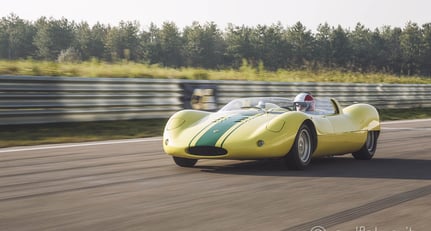1964 De Sanctis Sport SP1000
Sport SP 1000-
Year of manufacture3/1964
-
Car typeOther
-
Chassis number002
-
Competition carYes
-
FIA PapersYes
-
DriveLHD
-
ConditionOriginal Condition
-
Interior colourBlack
-
Number of doors2
-
Number of seats2
-
Location

-
Exterior colourYellow
-
GearboxManual
-
Performance100 BHP / 102 PS / 75 kW
-
Drivetrain2wd
-
Fuel typePetrol
Description
History of the model
The De Sanctis SP 1000 is the only model of a Sport car from De Sanctis company, built in 3 samples: Luigi (Gino) and his son Lucio De Sanctis decided to build this sport aimed by the wish to win against the Lotus 23 with an engine by Giannini, driven by Cesare Toppetti.
At the end of 1963 De Sanctis began the project of the Sport: the first rolling chassis could be seen in the magazine Auto Italiana (November ‘63), while Bruno Nestola – journalist – and Ing. Palanca designed the shape of this car, then realized by Carrozzeria Filacchione (in Rome), which already built the bodies of the De Sanctis formulas. The final body of the car appeared moden, fluent and slender with the typical De Sanctis 6 air-intakes on the front hood; the car also had two hidden headlights – according to the rules of that period - and two slim intakes right below the seats to bring fresh air into the engine bay.
During the first months of 1964 Lucio De Sanctis carried on the testing sessions of the car thanks to his racing experience with Formula 830 and Formula 3. The testing car would have been sold to Sergio Bettoja with dry-sump Ford engine, derived by Formula Junior, while the second chassis with OSCA engine had been bought by Sesto Leonardi, a mid-aged driver with years of experience into motorsport (he started racing in late ‘30s). The third engine would have been built latter for Alberto Luti (AKA Gano) with a 2000 OSCA engine with a slightly different body, larger in its proportions.
The tireless chassis 002
This car with chassis number 002 was bought by Sesto Leonardi who asked specifically the 1000 OSCA engine and some specs, different from the prototype 001: a different position for the rev counter for a “less layed down” driving postion and a higher engine lid to fit the twin-cam engine; this car weighted 442 kilos, 4 more than the 001 chassis because of the lighter Ford engine. Both cars mounted a 5 gears Colotti-Dauphine gearbox and were painted red.
The two cars debuted the 22nd March 1964 in the Sport category attending the XXX Coppa Gallenga: Bettoja finished 2nd in its class while Leonardi was retired. Few weeks later Sesto Leonardi raced the Coppa della Consuma but the car was too “modern” for his driving experience made of front engine cars: so the car came back to the Factory and at the end of May had been equipped with a 85hp Ford Engine, probably from the De Sanctis Formula 2 that raced in Berlin with Silvio Moser.
With the new engine, the car won the IV Premio di Campagnano driven by Miro Gay (Lillo Annunziata) then with another engine, a twin-cam Ford-Lotus with 115 hp, the car reached the second place at the III Coppa Settecolli, driven by Lucio De Sanctis who drove the car also at the V Premio of Campagnano, last overall race for Lucio.
The same year, Bettoja’s car was sold to Roberto Benelli (Robertino) who raced the Cesana-Sestriere and the Coppa Avezzano (finished 1st in class and 3rd overall). After there two races the car had been painted with the official De Sanctis livery: light yellow with a green stripe in the middle. Despite the good performances of the cars, the “1000 Sport class – track” championship of 1964 would had been won by Cesare Toppetti’s Lotus-Giannini, while the hillclimb championship went to Vittorio Venturi with Abarth.
At 1965 Saloncino di Modena, De Sanctis exposed Robertino’s SP1000 and the rolling chassis of the 2000 OSCA for Gano.
At the ’65 edition of the Coppa Gallenga, the three De Sanctis Sport were racing: Robertino retired, Gano finished 3rd in class 2000 and Geki, with the “works car” chassis 002, won his class. During the year this car raced with Cesare Toppetti, Antonio Maglione and Otello Rinaldi who gained the pole-position and won the IV Coppa Settecolli.
The same year, Robertino raced the Bologna-Raticosa hillclimb, then Circuito del Mugello, Coppa della Consuma and won the 1st prize at the hillclimb Vergato-Cereglio, first overall success for the car. At the end of the year, Robertino updated the car with a 2000 ATS engine and with a new fiberglass body; thanks to the upgrade Robertino won the Lago-Montefiascone hill-climb then sold the car to Cesare Toppetti who alternated the 1000 and the 2000 engines gaining some podiums. Still in 1965 Gano won in Volterra, finished second in Predappio but retired in Vallelunga and in Circuito del Mugello.
Updates over updates
In 1966 sport-protoype cars received less restrictive regulations so De Sanctis presented in February ad Torino auto show and in March at Modena sports cars show the same “Works car” (chassis 002) with a new – less charming – body, higher windshield made of glass. The car could fit 1000, 1600 or 2000 engines with Colotti 5 or 6 gearbox. Despite the two shows, nobody ordered any new Sport so the chassis 002 – a development chassis – had been given to Luciano Verrocchio (AKA Ellevù): same engine, gearbox and Campagnolo wheels with new updates on the rear suspensions inspired by the Formula 3 experience. With the new car Ellevù raced and won the 1st class prize both at the Bologna-Raticosa hillclimb and at the Gran Premio di Campagnano; he raced also the Trento-Bondone and the Circuito del Mugello with the english race driver Jonathan Williams – official De Sanctis race driver. Ellevù ended the season in 3rd place of the Campionato Italiano Sport Prototipi up to 1000.
From “barchetta” to “berlinetta”
In 1967 Ellevù, during the Cesana-Sestriere hillclimb had an accident: the body burned while the chassis had been reparied by De Sanctis who decided to send it to Modena by Piero Drogo owner of “Carrozzeria Sports Cars”, bodyshop where Ferrari built masterpieces such as the 250 GTO, the SWB the Le Mans, the Dino 206SP, the P3 and the P4.
Taking inspiration by his Dino 206SP and his P4 (he used also that windshield, a little bit too large for the small De Sanctis), he reproduced the same style on the SP1000 which became a Sport car with closed cockpit (Berlinetta). Drogo took some time to re-style the De Sanctis so it couldn’t attend the 1967 Circuito del Mugello; the “new” car debuted at the end of the year driven by Ellevù at Svolte di Popoli and Ascoli-Colle San Marco hillclimbs.
Many italian magazines wrote about that new charming racing car and in the first months of 1968 Cristiano Del Balzo (AKA Gero), young De Sanctis racing driver bought the car by Gino De Sanctis.
In 1968 Gero raced the Targa Florio and the Circuito del Mugello with Erik Banti: in both races they retired (in Mugello for overheating). Even if it was really charming the new body weighted too much for the little engine which coudn’t “breath” as it should.
In 1969 the car raced the Targa Florio driven by Erik Banti and Francesco Morelli and, also that time, it retired for a little crash.
A second time with open top
So, in 1970, Gero decided to cut the roof and the tail in order to reduce the weight of the car and increase the cooling of the engine. Even with the new layout the car seemed the Ferrari P4 “barchetta” (it was the same upgrade of the De Sanctis made on the Ferrari). The new car, now with blue and orange body raced its third Targa Florio driven by Gero and Roger, the Circuito del Mugello and other hill-climbs as the Tolentino-Colle Paterno, the last race where Gero won his class.
Back on Vallelunga racetrack
It should have finished its career in 1970 but the De Sanctis was still interesting and useful, also thanks to the upgrades: in the first ‘70s the car had been sold to Henry Morrogh who used it as a training car during the courses of his Driving School based in Vallelunga: aside the insructor, for 1.000 Lire per lap, many young aspiring race drivers used this car, to learn the “heel-toe”, correct lines and braking, before getting on the single-seater; some of them, later on became champions, such as Elio De Angelis, Eddy Cheever, Teo Fabi and Andrea De Cesaris…by the way all the race-drivers who attended the school between 1975 and 1985, for sure will remember this car.
In mid-80’s the car had been bought and restored by the current owner: the body gained its original shape by Autorestauri Faralli from Cascina (PI) and by the mechanic and race-driver Pierluigi Muccini who knew the De Sanctis Sport because in the past years he raced with the ex Bettoja and Robertino’s car. The livery was the original of the racing Sport by Robertino. Since the end of the restoration in 1989 the car never saw any kind of road or track. The car will be delivered also with the cut Drogo aluminium body (as an open sports car), used in the 70’s by Gero and then by Henry Morrogh. It is also available the original Colotti-Dauphine gearbox.
The car mounts a Ford engine 109 E, dry sump, with two Weber carburetors 40 DCOE19, the gearbox is a Hewland MK6, 4 speed, supplied by Henry Morrogh. The car is supplied with the FIA HTP from 1989 and with many photos of the car during its racing career.
Car eligible to the main classic cars events, such as Goodwood Revival, Members meeting, Festival of Speed, Vernasca Silver Flag, European and Italian Historic Championship - track and hillclimb.
The car could be seen in Italy, near Rimini.
Further photos and information on our website www.gulfblue.it
Here a short video of the car: https://www.youtube.com/watch?v=vvD078K97UU

























